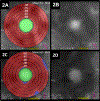Perivascular fat attenuation for predicting adverse cardiac events in stable patients undergoing invasive coronary angiography
- PMID: 35680534
- PMCID: PMC9684349
- DOI: 10.1016/j.jcct.2022.05.004
Perivascular fat attenuation for predicting adverse cardiac events in stable patients undergoing invasive coronary angiography
Abstract
Background: Inflammation surrounding the coronary arteries can be non-invasively assessed using pericoronary adipose tissue attenuation (PCAT). While PCAT holds promise for further risk stratification of patients with low coronary artery disease (CAD) prevalence, its value in higher risk populations remains unknown.
Methods: CORE320 enrolled patients referred for invasive coronary angiography with known or suspected CAD. Coronary computed tomography angiography (CCTA) images were collected for 381 patients for whom clinical outcomes were assessed 5 years after enrollment. Using semi-automated image analysis software, PCAT was obtained and normalized for the right coronary (RCA), left anterior descending (LAD), and left circumflex arteries (LCx). The association between PCAT and major adverse cardiovascular events (MACE) during follow up was assessed using Cox regression models.
Results: Thirty-seven patients were excluded due to technical failure. For the remaining 344 patients, median age was 62 (interquartile range, 55-68) with 59% having ≥1 coronary artery stenosis of ≥50% by quantitative coronary angiography. Mean attenuation values for PCAT in RCA, LAD, and LCx were -74.9, -74.2, and -71.2, respectively. Hazard ratios and 95% confidence intervals (CI) for normalized PCAT in the RCA, LAD, and LCx for MACE were 0.96 (CI: 0.75-1.22, p = 0.71), 1.31 (95% CI: 0.96-1.78, p = 0.09), and 0.98 (95% CI: 0.78-1.22, p = 0.84), respectively. For death, stroke, or myocardial infarction only, hazard ratios were 0.68 (0.44-1.07), 0.85 (0.56-1.29), and 0.57 (0.41-0.80), respectively.
Conclusions: In patients referred for invasive coronary angiography with suspected CAD, PCAT did not predict MACE during long term follow up. Further studies are needed to understand the relationship of PCAT with CAD risk.
Keywords: Coronary artery disease; Coronary computed tomography angiography; Coronary heart disease; Multidetector computed tomography; Perivascular fat attenuation.
Copyright © 2022 Society of Cardiovascular Computed Tomography. Published by Elsevier Inc. All rights reserved.
Figures




References
-
- Antonopoulos AS, Sanna F, Sabharwal N, Thomas S, Oikonomou EK, Herdman L, et al. Detecting human coronary inflammation by imaging perivascular fat. Sci Transl Med. 2017;9(398). - PubMed
-
- Antonopoulos AS, Antoniades C. Perivascular Fat Attenuation Index by Computed Tomography as a Metric of Coronary Inflammation. J Am Coll Cardiol. 2018. Jun 12;71(23):2708–9. - PubMed
-
- Oikonomou EK, Marwan M, Desai MY, Mancio J, Alashi A, Hutt Centeno E, et al. Non-invasive detection of coronary inflammation using computed tomography and prediction of residual cardiovascular risk (the CRISP CT study): a post-hoc analysis of prospective outcome data. Lancet [Internet]. 2018;392(10151):929–39. Available from: 10.1016/S0140-6736(18)31114-0 - DOI - PMC - PubMed
MeSH terms
Grants and funding
LinkOut - more resources
Full Text Sources
Medical
Miscellaneous

